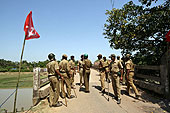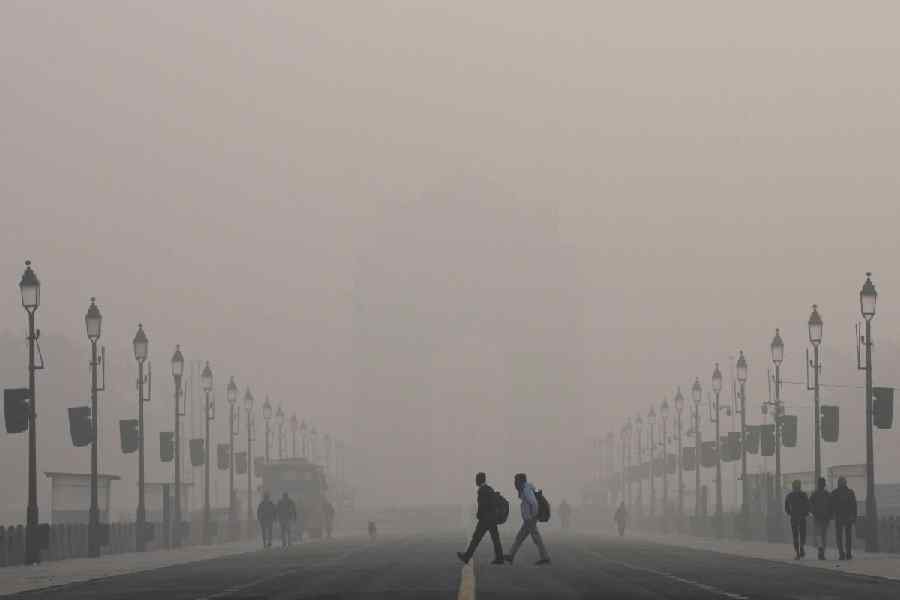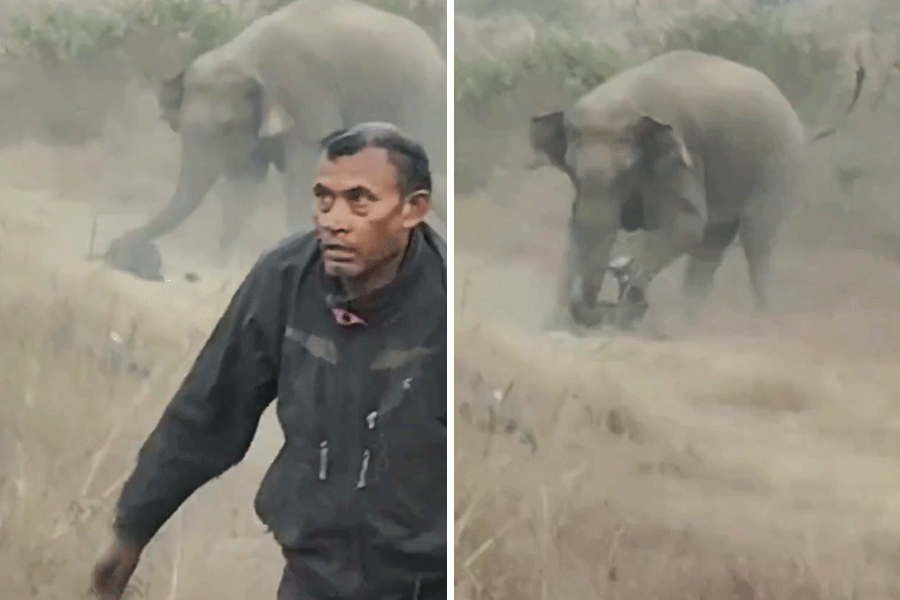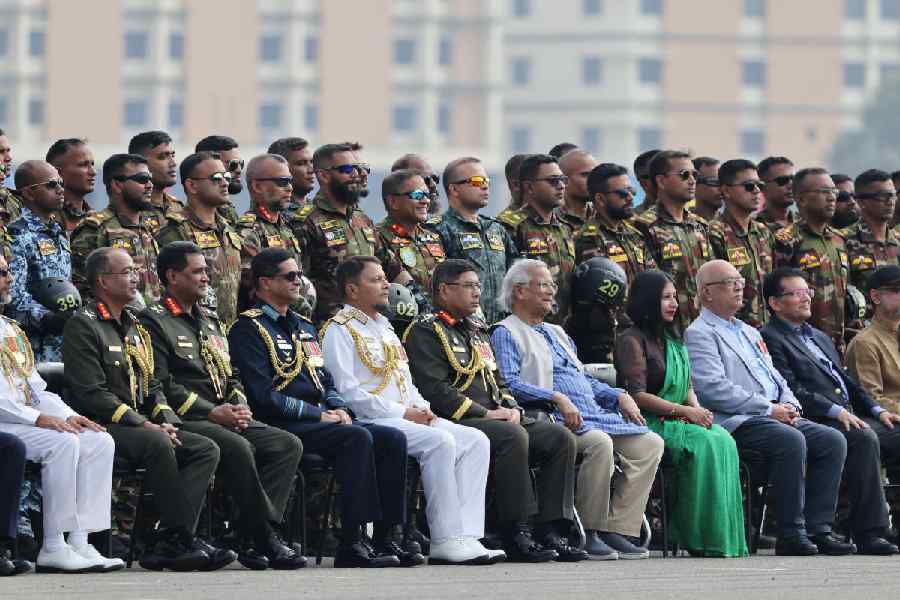 |
 |
| UNDER SIEGE: A villager in Sonachura points to Bhangabera bridge (above) Picture by Suman Mondal (picture below) |
The man squishes through the muddy banks of the Talpati canal on the edge of Nandigram. A rail-thin figure with a thatch of unruly hair, he looks somewhat disorientated. With his probing, deep-set eyes, he stares at a cluster of thatched houses on the other side of the canal. Villagers mill around him, but he pays no heed to them.
A violent spiral of land politics has torn Kalipada Shit from his family. The 35-year-old finds himself marooned in a makeshift shelter in the Opposition-controlled Sonachura village, cut off from his family and livelihood. On the other side of the canal, at the red bastion of Khejuri, his wife Champarani and their four children live what he figures is a life of hell. A small, concrete bridge spans the canal hardly 100 feet wide.
Yet Kalipada cannot cross the Bhangabera bridge — the mute witness to the Nandigram carnage — to meet his family or to clasp to his chest his three-month-old son whom he affectionately calls Naroogopal. If he could stand on the bridge and shout, his family on the other side would hear him. But then, Kalipada cannot raise his voice without inviting reprisal. He says his family is “in the clutches” of the CPI(M) at Khejuri, the village he was forced to flee.
He was driven out of his home much before the police, with machete-and-gun-wielding suspected CPI(M) cadres in tow, stormed Sonachura on March 14, killing 14 people and wounding scores. Reason: he had dared to join a “save land” movement while living in a CPI(M) stronghold. Like many others in the Sonachura relief camp, who too were forced to flee their homes for joining the agitation, Kalipada feels like a refugee in his homeland. “It’s all our area but they cannot come to me and I cannot go to them,” he says.
Though the Buddhadeb Bhattacharjee government has scrapped its plans to include Nandigram in a proposed chemical hub by Indonesia’s Salim group, the administration has so far made little attempt to take people like Kalipada back to their villages. Unlike the ousted CPI(M) supporters who were brought to Calcutta by the party leadership early this week to showcase their plight, few visit the squalid camp at Sonachura, where Kalipada sleeps fully clothed fearing another attack. Who knows, he says, “they” might cross the bridge one night to “get us”.
What he, however, cannot fathom is how the Bhangabera bridge, which he had crossed incalculable times since his childhood, has cut his world in two. The bridge is a metaphor for his plight — standing between him and his family.
And make no mistake about this. Nandigram is no longer a plain and simple land issue. Starting as a tussle between the villagers and the Left Front government over land acquisition, the issue has turned into a turf battle between the CPI(M) and the Trinamool Congress, the principal Opposition party. The fluttering flags at both ends of the bridge — the Trinamool’s in Sonachura and the CPI(M)’s in Khejuri — signify the political chasm in Nandigram, a rural block in Bengal’s East Midnapore district. And Trinamool’s gain is clearly the CPI(M)’s loss.
As Maidur Hossain, convenor of the Bhumi Uchched Pratirodh Committee, which is spearheading the agitation, puts it, Mamata Banerjee’s party was “heard of but never seen” until the movement against land acquisition started in Nandigram four months ago. Lakshman Seth, the local CPI(M) MP, squarely blames the Trinamool for the March 14 incident saying it was “the outcome of violent politics.”
Ironically, Kalipada today feels protected under the Trinamool flag, but red was the colour he grew up with. His late father, Barendranath, a marginal farmer, worked for the CPI(M) and so did he for five years as a member of the CPI(M)’s Krishak Sabha. But he says he was disillusioned by the nepotism and corruption of local party leaders. “If you applied for Rs 20,000 to build your house under the Indira Awas Yojana, you had to give away Rs 1,000 as party chanda (contribution) and Rs 4,000 as commission to panchayat leaders who helped you get it.”
Before the 2004 Lok Sabha elections, he thought he’d had enough and resigned from the Krishak Sabha and joined the Congress (I). Trouble started when he started participating in rallies in support of Nandigram villagers facing displacement. He was repeatedly threatened he would be killed. Then, on the night of February 17, he rose to the sounds of exploding bombs. His wife told him to flee, assuring him that they were unlikely to harm her or the children.
In the inky dark, Kalipada raced blindly to the Talpati canal, jumped into the freezing water and swam across to Sonachura. His eyes reflect the horror of that night as he recalls it.
He could never go back. His wife tried to cross the bridge but was stopped. “They told her that if she steps onto the Bhangabera bridge, she would have to pay a fine of Rs 1,001 and if she ever crosses it, the fine would go up to Rs 5,001 and that our house would be locked up,” Kalipada says. That was enough to deter Champarani from crossing over.
Before leaving home, Kalipada worked as a labour supplier, earning enough commission to make him dream of building a concrete house one day and putting his children to school, something he could not finish for want of money.
Three weeks ago, he met a neighbour at Sonachura bazar, who told him that his infant son had fever but his wife had been prevented by local partymen from taking him to a homoeopathic physician the family consulted in Sonachura. She was asked to take her child to an allopathic doctor in Kunjapur. The homoeopathic doctor was cheap and effective. A visit to the allopathic doctor would cost as much as Rs 60.
Luckily for the family, a neighbour took pity on the sick child, paid the fee and bought the medicines. His son got better, as he learnt later. Neighbours visiting the Sonachura bazar are his only source of news about his family.
For more than one month, he hasn’t earned a rupee as all development work has come to a standstill in Nandigram. Each day is a struggle — he doesn’t know how many more he will have to spend tethered to the relief camp. The family is so near — and yet so far away.











